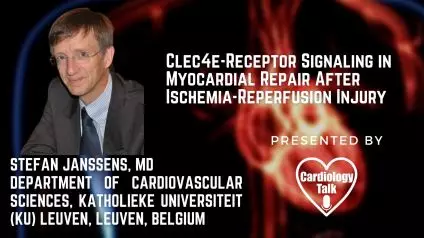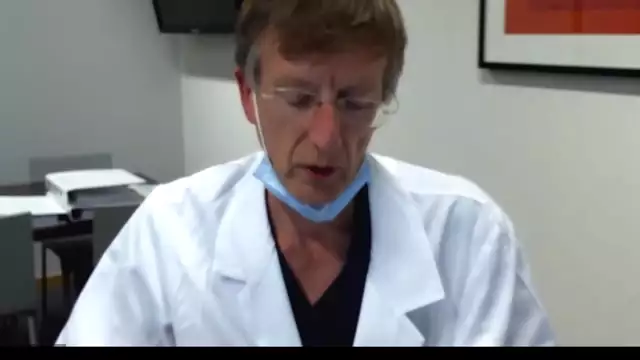Stefan Janssens, MD- #KatholiekeUniversiteit #MyocardialRepair #Cardiology #Research -Clec4e-Receptor Signaling in My...
Stefan Janssens, MD-
Link to Article- https://www.jacc.org/doi/10.1016/j.jacbts.2021.07.001
• It is uncertain what role CLEC4E plays in myocardial repair following ischemia-reperfusion damage.
• Deletion of CLEC4E is linked to decreased cardiac damage, inflammation, and structural and functional remodeling of the left ventricle.
• CLEC4E is a promising target for reducing myocardial inflammation and improving ischemia-reperfusion damage repair.
Summary
C-type lectin domain family 4 member E (CLEC4E) from bacteria has a vital function in sterile inflammation, although its significance in myocardial healing is uncertain. We show that CLEC4E expression levels in the myocardium and blood correspond with the extent of myocardial injury and left ventricular (LV) functional impairment using complementary techniques in porcine, murine, and human tissues. In the ischemic heart, CLEC4E expression is dramatically enhanced in the vasculature, cardiac myocytes, and infiltrating leukocytes. A reduction in acute cardiac damage, neutrophil infiltration, and infarct size has been linked to the loss of Clec4e signaling. At 4 weeks, Clec4e–/– had considerably enhanced LV structural and functional remodeling due to reduced myocardial damage. The early transcriptome of Clec4e–/– mice LV tissue revealed considerable overexpression of transcripts involved in myocardial metabolism, radical scavenging, angiogenesis, and extracellular matrix organization compared to wild-type mice. As a result, targeting CLEC4E in the early stages of ischemia-reperfusion injury offers a prospective therapeutic method for modulating myocardial inflammation and enhancing myocardial healing.
Introduction
After a myocardial infarction, cardiac repair is a highly organized and complex series of processes that begins with an inflammatory phase marked by immune cell infiltration and the production of danger-associated molecular patterns (DAMPs) and then progresses to a reparative and proliferative phase (1-3). To allow later tissue healing and prevent maladaptive left ventricular (LV) remodeling, faulty scar formation, and poor patient outcome, the early inflammatory response with DAMPS binding to cognate pattern recognition receptors (PRRs) must be correctly and timely coordinated (4,5). Excessive or protracted inflammation causes ventricular dilatation and systolic dysfunction, increasing the likelihood of heart failure (6), whereas insufficient early inflammation fails to remove necrotic cardiac cells and matrix components, obstructing eventual tissue healing. The importance of a better understanding of the cellular and molecular pathways directing this biphasic repair process following ischemia-reperfusion (I/R) injury is highlighted by this complex and tightly regulated innate immune activation response.
Previously, we looked examined how the transcriptional profile of patients with an acute myocardial infarction (AMI) changed over time in circulating blood cells (7). We found that pro-inflammatory pattern recognition receptors, such as the C-type lectin domain family 4 member E receptor (CLEC4E), which is normally expressed on leukocytes and activated in response to bacteria, were highly activated (8,9). In vitro, this innate immune receptor detects necrotic material caused by ischemia injury (10) and suppresses the inflammatory response in experimental murine brain injury (11,12). CLEC4E's role in myocardial I/R damage, on the other hand, is uncertain.
The significance of CLEC4e signaling in the early inflammatory response and subsequent healing phase following acute myocardial ischemia injury was studied in this study, as well as its potential as a new target for intervention in myocardial I/R injury.
Methods
Ethics
The Ethics Committee for Animal Experimentation at KU Leuven (P244/2014 and P064/2017) approved all animal procedures, which were carried out in accordance with Belgian law on the care and use of experimental animals. The patient research procedure followed the Declaration of Helsinki, and all patients signed informed permission (Ethical Committee ML8525, Belgian trial no. B322201214942, S54129) (7).
I/R damage in a porcine model and cardiac magnetic resonance imaging
As previously documented, ten domestic pigs (body weight: 20-30 kg) were sedated, anesthetized, and had I/R damage by transient balloon blockage of the left anterior descending coronary artery (LAD) distal to the first diagonal branch for 50 minutes, followed by 4 hours of reperfusion (7). After 4 hours of reperfusion, a subgroup of 6 pigs underwent 3-T cardiac magnetic resonance imaging (MRI) (Prisma-Tim, Siemens) to assess infarct size (MI/left ventricle), end-systolic volume (ESV), end-diastolic volume (EDV), and ejection fraction, before being euthanized (13). Biopsy specimens were taken from the left ventricle's ischemia, border, and distant zones for differential gene expression analysis and histology. Supplementary Materials and Methods, as well as Supplementary Table 1, give more information.
I/R damage in a mouse model and cardiac MRI
Male C57Bl6/J wild-type (WT) mice aged 12 to 14 weeks were crossed with Clec4e–/– mice (031936-UCD) purchased from the Mutant Mouse Resource and Research Center. Mice were given I/R damage by ligating the LAD for 60 minutes and then reperfusing them, as described before (14). They were randomly assigned to evaluate arms with reperfusion for 24 hours (WT, n = 12; Clec4e–/–, n = 14), 72 hours (WT, n = 5; Clec4e–/–, n = 5) or 4 weeks (WT, n = 17; Clec4e–/–, n = 16). Investigators blinded to the genotype of the animals obtained cardiac MRI data on a Bruker BioSpec 70/30 7T MRI machine (Bruker BioSpin) after 4 weeks of reperfusion. Blood was taken from the inferior caval vein after euthanasia to measure high-sensitivity troponin I (hs-TnI) as a surrogate marker of cardiac injury and to isolate neutrophils to study their phenotype and migration capacity; at 24 hours after I/R injury, LV tissue was taken for histological analysis and transcriptome studies. Organs were perfused for 10 minutes with saline before being harvested for histological and differential gene expression analyses utilizing ribonucleic acid (RNA) sequencing and quantitative real-time polymerase chain reaction (qRT-PCR). The Supplementary Materials and Methods section has more information.




